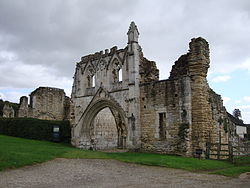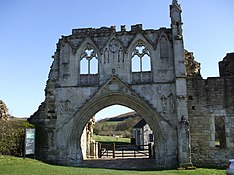| Kirkham Priory | |
|---|---|
 | |
| Location | Kirkham, North Yorkshire |
| Nearest city | York |
| Coordinates | 54°04′58″N 0°52′36″W / 54.0829°N 0.876675°W |
| Built | 12th century |
Listed Building – Grade I | |
| Official name | Kirkham Priory |
| Designated | 11 February 1987 |
| Reference no. | 1149116[1] |
| Official name | Kirkham Priory Augustinian monastery: monastic precinct, three fishponds, and precinct boundary |
| Designated | 9 October 1981 |
| Reference no. | 1014024[2] |

The ruins of Kirkham Priory are situated on the banks of the River Derwent, at Kirkham, North Yorkshire, England. The Augustinian priory was founded in the 1120s by Walter l'Espec, lord of nearby Helmsley, who also built Rievaulx Abbey. The priory was surrendered in 8 December 1539 during the Dissolution of the Monasteries. Legend has it that Kirkham was founded in remembrance of l'Espec's only son who had died nearby as a consequence of his horse being startled by a boar. The area was later used to test the D-Day landing vehicles, and was visited by Winston Churchill.[3] The ruins are now Grade I listed and a scheduled monument in the care of English Heritage.
Gatehouse ruins
[edit]The Gatehouse of Kirkham Priory, built c. 1290–95, is a specimen of English Gothic medieval architecture. It is a rare survival of such a gatehouse, comparable to that of Butley Priory in Suffolk. It has a wide arch of continuous mouldings with a crocketed gable running up to the windows, with sculptures of St George and the Dragon on the left, and David and Goliath to the right. Above the arch is Christ in a pointed oval recess, plus two figures below of St Bartholomew and St Philip, in niches. There are also many escutcheons with the armorials of the various benefactors of the Priory, including the arms of de Ros, Scrope, de Forz, Vaux, FitzRalph & Espec (3 cart-wheels, each with 6 spokes).
Burials
[edit]- Sir William de Ros (b. before 1200 – d. ca. 1264/1265), father of Robert de Ros, 1st Baron de Ros.
- Robert de Ros (died 1285)
- William de Ros, 1st Baron de Ros
- William de Ros, 2nd Baron de Ros
- Ralph Greystoke, 5th Baron Greystoke
Preparation for D-Day landings in the Second World War
[edit]During the Second World War, the priory was used by the military in training for what became the largest seaborne invasion in history, the D-Day landings which took place on 6 June 1944. Amongst units moved to Kirkham were the British 11th armoured division, the aim being to give drivers experience of manoeuvring and to test various waterproofing compounds and to gain experience with equipment to be used in the landings. Tanks, jeeps and other military vehicles destined for the landings were put through their paces at the priory and on the banks of the River Derwent. Troops made use of the high wall of the Western Cloister in training with scrambling nets, which they would subsequently use to make their way from the main transport ships into the smaller landing craft during the invasion. Prime Minister Winston Churchill and King George VI visited the priory in secret to monitor preparations, an indication of Kirkham's significance as a training ground.
Further reading
[edit]- "Houses of Austin canons: Priory of Kirkham". A History of the County of York: Volume 3. Victoria County History (digital version courtesy of British History Online). 1974. pp. 219–222.
- English Heritage Listed Buildings text
References
[edit]- ^ Historic England. "Details from listed building database (1149116)". National Heritage List for England. Retrieved 23 April 2022.
- ^ Historic England. "Details from listed building database (1014024)". National Heritage List for England. Retrieved 1 December 2016.
- ^ David Prudames (21 May 2004). "Yorkshire priory commemorates Churchill's secret visit on eve of D-Day". Culture24. Retrieved 7 December 2009.
External links
[edit]- Kirkham priory Archived 16 August 2004 at the Wayback Machine
- Priory Portal
- Visitor information: English Heritage
- Historic England. "Details from listed building database (1149116)". National Heritage List for England.
- Map sources for Kirkham Priory


